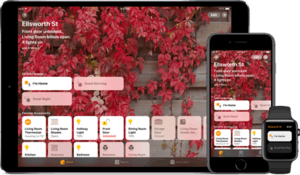HomeKit
HomeKit is a software framework by Apple that lets users configure, communicate with, and control smart-home appliances using Apple devices. By designing rooms, items, and actions in the HomeKit service, users can enable automatic actions in the house through a simple voice command to Siri or through the Home app.[1]
.png) | |
 | |
| Other names | Home |
|---|---|
| Developer(s) | Apple Inc. |
| Operating system | iOS, iPadOS, macOS, watchOS, and tvOS |
| Type | Home automation |
Overview
HomeKit uses Bluetooth and Wi-Fi protocols.[2] Manufacturers of HomeKit-enabled devices are required to enroll in an MFi Program,[3] and initially all HomeKit-based products were required to include an encryption co-processor.[4] The latter requirement was later changed in iOS 11, which added support for software-based authentication.[5] Equipment manufactured without HomeKit support can be enabled for use through a "gateway" product, a bridge that connects those devices to the HomeKit service.[6]
HomeKit primarily competes with smart home standards from Amazon and Google. As of October 2019, Apple lists 450 devices compatible with HomeKit, compared to 10,000 for Google and 85,000 for Amazon.[7]
Device categories
HomeKit currently supports 22 device categories:[8]
Garage doors, locks, security systems, and windows are categorized as secure appliances, and requires a device with authentication such as an iPhone or iPad to control.
Home app
iOS version
HomeKit was first released with iOS 8 in September 2014. The framework allowed third-party apps to interface with HomeKit devices using Siri and allow remote access through home hubs.[11]
The Home app was first released with iOS 10 in September 2016 to unify all devices into one app.[12] It added support for automations using a home hub, and preprogrammed "Scenes", which can set multiple devices using a single command.[13]
macOS version
The Home app was added to Macs with macOS 10.14 Mojave in September 2018.
HomePod and Apple TV
The HomePod and fourth-generation and newer Apple TV lack a graphical user interface to control HomeKit devices, and instead use Siri voice commands. They cannot control secure devices.[14]
References
- Ritchie, Rene (August 27, 2014). "HomeKit in iOS 8: Explained". iMore. Retrieved December 26, 2016.
- Chin, Monica; Chang 2019-09-27T15:27:35Z, Althea. "Apple HomeKit: What Is It, and How Do You Use It?". Tom's Guide. Retrieved 2020-01-06.
- "Working with HomeKit". Apple Inc. Retrieved December 26, 2016.
- Higginbotham, Stacey (June 10, 2015). "What one startup CEO learned from handling Apple's HomeKit mess". Fortune. Time Inc. Retrieved December 26, 2016.
- "How HomeKit's software authentication works". 29 March 2018.
- Ricker, Thomas; Kastrenakes, Jacob (January 8, 2015). "First HomeKit devices confirm Apple TV's limited role in home automation". The Verge. Vox Media. Retrieved December 26, 2016.
- Porter, Jon (2019-10-28). "HomeKit might be fading, but Apple's not giving up yet". The Verge. Retrieved 2020-01-05.
- "iOS - Home". Apple. Retrieved 2019-12-26.
- "Set up your HomePod, Apple TV, or iPad as a home hub". Apple Support. Retrieved 2019-12-26.
- Hall, Zac (2016-09-16). "HomeKit automation no longer works with third-gen Apple TV after iOS 10 (Updated: Apple clarifies)". 9to5Mac. Retrieved 2019-12-26.
- Rossignol, Joe. "Getting Started With HomeKit: A Beginner's Guide". www.macrumors.com. Retrieved 2019-12-26.
- "How to add a home to the new Home app in iOS 10". iMore. 2016-08-23. Retrieved 2019-12-26.
- Clover, Juli. "Here's the New 'Home' App for Controlling HomeKit Devices in iOS 10". www.macrumors.com. Retrieved 2019-12-26.
- "Other things you can ask Siri on Apple TV". Apple Support. Retrieved 2019-12-26.
External links
- Apple Products Page
- Homebridge, an open source implementation of the Apple Home Automation Protocol
- HomeKit Subreddit
- HomeKit Framework
- HomeKit Developer Guide
- Apple's Developing for HomeKit guide